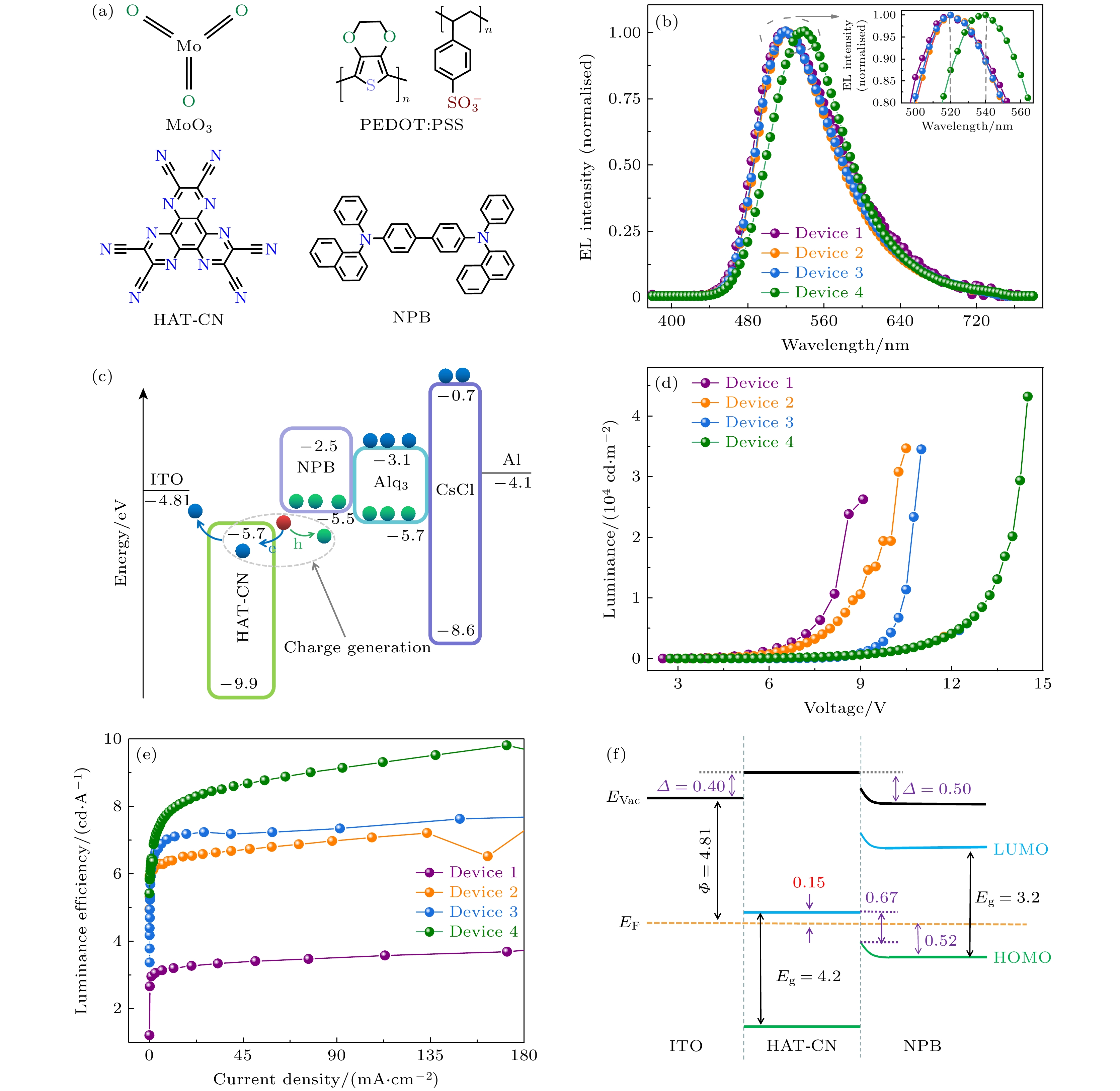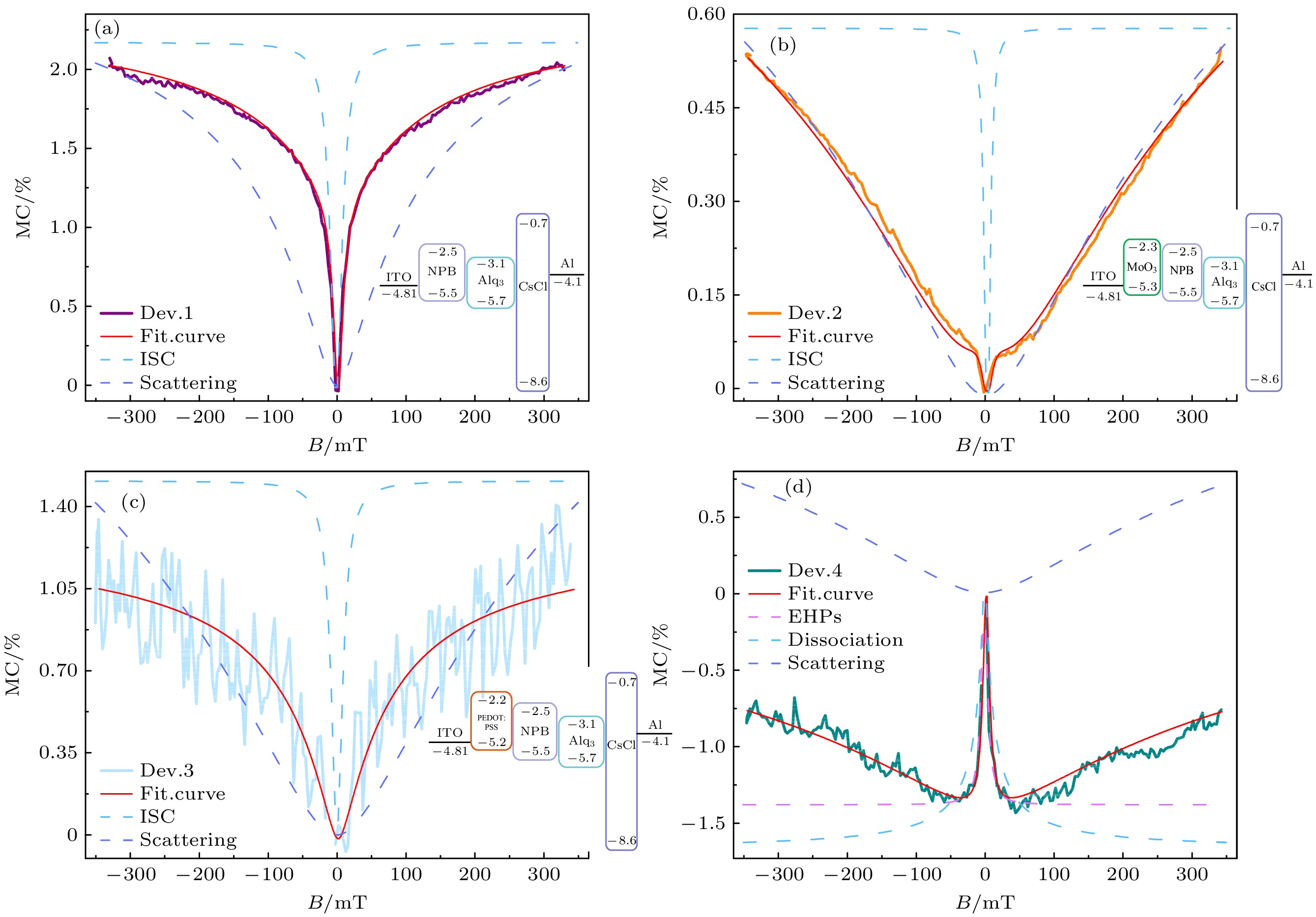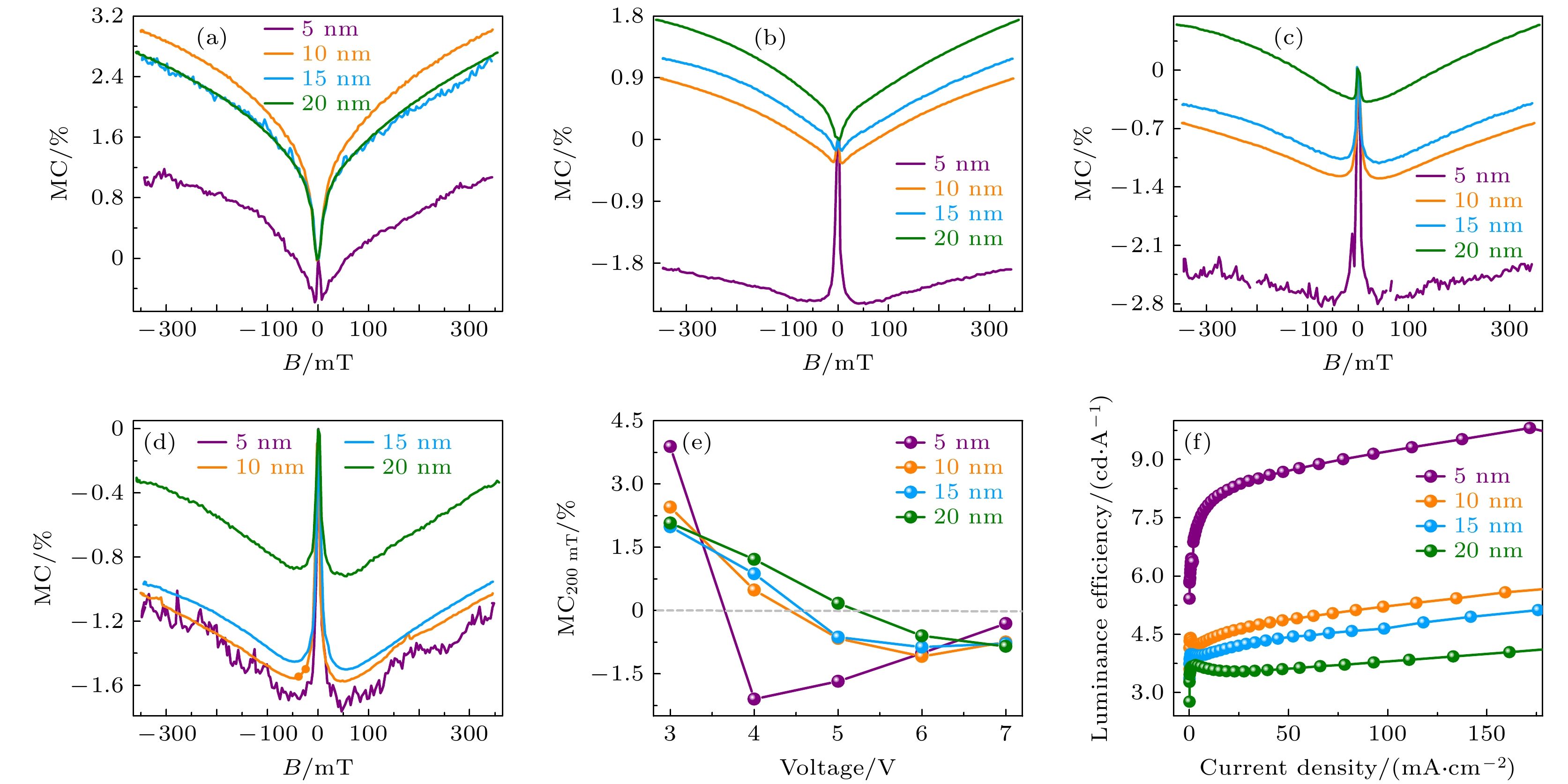-
Triplet exciton-charge interaction (TQI) has two forms: dissociation and scattering, However, it is still unclear how the hole injection layer affects the dissociation and scattering of triplet excition and the transition between positive and negative values of magneto-conductance (MC). In this paper, HAT-CN, which can produce carrier ladder effect, is used as hole injection layer (HIL), and magnetic effect is used as a tool to study it. The results show that there are three characteristic magnetic fields in the device: hyperfine, dissociation and scattering, which are verified by fitting the MC with Lorentzian and non-Lorentzian functions. The hyperfine characteristic magnetic field results from the magnetic field suppressing superfine field-induced charge-spin mixing. With the enhancement of magnetic field, hole injection layer/hole transport layer interface produces carrier ladder effect, which improves the hole injection efficiency. The triplet excitions are separated by the hole, then the secondary carriers are produced, which makes the device’s luminous brightness and efficiency reach to 43210 cd/m2 and 9.8 cd/A, respectively. The carrier ladder effect will also lead to a large accumulation of injected charges, resulting in the scattering of charge carriers by triplet excition, thereby reducing their mobility, which is not conducive to the formation of excited states nor device luminescence. The MC is modulated by KS/KT (recombination rate ratio), and when the electric field is small
$ {K}_{{\rm{S}}}\gg {K}_{{\rm{T}}} $ , the recombination ratio is relatively large, resulting in positive MC. With the increase of electric field$ {K}_{{\rm{S}}}\approx {K}_{{\rm{T}}}=K$ , KS/KT approaches 1 at this time, resulting in an MC, which is negative in a low temperature environment. This work provides a novel approach for regulating and effectively utilizing triplet excitons.-
Keywords:
- HAT-CN /
- organic light-emitting diode /
- hole injection layer /
- magnetic conductivity
[1] Yuan J K, Dai Y F, Sun Q, Qiao X F, Yang D Z, Chen J S, Ma D G 2019 Semicond. Sci. Technol. 34 105010
 Google Scholar
Google Scholar
[2] Chang Q, Lü Z Y, Yin Y H, Xiao J, Wang J L 2022 Displays 75 102306
 Google Scholar
Google Scholar
[3] Oh E, Park S, Jeong J, Kang J S, Lee H, Yi Y 2017 Chem. Phys. 668 64
[4] Liu Z Y, Wei P C, Bin Z Y, Wang X W, Zhang D D, Duan L 2021 Sci. China Mater. 64 3124
 Google Scholar
Google Scholar
[5] Park H G, Park S G 2019 Coatings 9 648
 Google Scholar
Google Scholar
[6] Chen Y B, Jia W Y, Xiang J, Yuan D, Chen Q S, Chen L X, Xiong Z H 2016 Org. Electron. 39 207
[7] Hu B, Yue W 2003 Nat. Mater. 6 985
 Google Scholar
Google Scholar
[8] Desai P , Shakya P , Kreouzis T, Gillin W P, Morley N A, Gibbs M R J 2007 Phys. Rev. B 75 094423
 Google Scholar
Google Scholar
[9] Shao M, Yan L , Li M X, Llia I, Hu B 2013 J. Mater. Chem. C 1 1330
 Google Scholar
Google Scholar
[10] Park C H, Kang S W, Jung S G, Lee J D, Park Y W, Ju B K 2021 Sci. Rep. 11 3430
 Google Scholar
Google Scholar
[11] Wu F J, Zhao X, Zhu H Q, Tang X T, Ning Y R, Chen J, Chen X L, Xiong Z H 2022 ACS Photonics 9 2713
 Google Scholar
Google Scholar
[12] Mischok A, Hillebrandt S, Kwon S, Cather M C 2023 Nat. Photonics 17 393
 Google Scholar
Google Scholar
[13] Niu L B, Zhong Y, Chen L J, Zhang Q M, Guan Y X 2020 Org. Electron. 87 105971
 Google Scholar
Google Scholar
[14] 王辉耀, 宁亚茹, 吴凤娇, 赵茜, 陈敬, 朱洪强, 魏福贤, 吴雨廷, 熊祖洪 2022 物理学报 71 217201
 Google Scholar
Google Scholar
Wang H Y, Ning Y R, Wu F J, Zhao Q, Chen J, Zhu H Q, Wei F X, Wu Y T, Xiong Z H 2022 Acta Phys. Sin. 71 217201
 Google Scholar
Google Scholar
[15] Huh J S, Sung M J, Kwon S K, Kim Y H, Kim J J 2021 Adv. Funct. Mater. 31 2100967
 Google Scholar
Google Scholar
[16] Deng Z B, Lee S T, Webb D P, Chan Y C, Gambling W A 1999 Synth. Met. 107 107
 Google Scholar
Google Scholar
[17] Kepler R G, Beeson P M, Jacobs S J, Anderson R A, Sinclair M B, Valencia V S, Cahill P A 1995 Appl. Phys. Lett. 66 3618
 Google Scholar
Google Scholar
[18] Chen B J, Lai W Y, Gao Z Q, Lee C S, Lee S T, Gambling W A 1999 Appl. Phys. Lett. 75 4010
 Google Scholar
Google Scholar
[19] Lee H, Cho S W, Yi Y 2016 Curr. Appl. Phys. 16 1533
 Google Scholar
Google Scholar
[20] Ding L, Sun Y Q, Chen H, Zu F S, Wang Z K, Liao L S 2014 J. Mater. Chem. C 2 10403
 Google Scholar
Google Scholar
[21] Weng Z C, Gillin W P, Kreouzis T 2019 Sci. Rep. 9 3439
 Google Scholar
Google Scholar
[22] Van Eersel, H, Bobbert P S, Janssen R A J, Coehoorn R 2016 J. Appl. Phys. 119 163102
 Google Scholar
Google Scholar
[23] Hu B, Yan L, Shao M 2009 Adv. Mater. 21 1500
[24] Bi H, Huo C Y, Song X X, Li Z Q, Tang H N, Griesse-Nascimento S, Huang K C, Cheng J X, Nienhaus L, Bawendi M G, Lin H Y G, Wang Y, Saikin S K 2020 J. Phys. Chem. Lett. 11 9364
 Google Scholar
Google Scholar
[25] Hayashi H, Sakaguchi Y, Wakasa M 2001 Bull. Chem. Soc. Jpn. 74 773
 Google Scholar
Google Scholar
[26] Kersten S P, Schellekens A J, Koopmans B, Bobbert P A 2011 Phys. Rev. Lett. 106 197402
 Google Scholar
Google Scholar
[27] Jia W Y, Zhang Q M, Chen L J, Ling Y Z, Liu H, Lu C L, Chen P, Xiong Z H 2015 Org. Electron. 22 210
 Google Scholar
Google Scholar
[28] Mark P, Helfrich W 1962 J. Appl. Phys. 33 205
 Google Scholar
Google Scholar
[29] Wohlgenannt M, Vardeny Z V 2003 J. Phys-condens. Mat. 15 R83
 Google Scholar
Google Scholar
[30] Gärditz C, Mückl A G, Cölle M 2005 J. Appl. Phys. 98 104507
 Google Scholar
Google Scholar
[31] Tang X T, Hu Y Q, Jia W Y, Pan R H, Deng J Q, He Z H, Xiong Z H 2018 ACS Appl. Mater. Inter. 10 1948
 Google Scholar
Google Scholar
[32] Zhang Q M, Chen L J, Jia W Y, Lei Y L, Xiong Z H 2016 Org. Electron. 39 318
 Google Scholar
Google Scholar
[33] Obolda A, Peng Q M, He C Y, Zhang T, Ren J J, Ma H W, Shuai Z G, Li F 2016 Adv. Mater. 28 4740
 Google Scholar
Google Scholar
[34] Tsai K W, Lee T H, Wu J H, Jhou J Y, Huang W S, Hsieh S N, Wen T C, Guo T F, Huang, J C A 2013 Org. Electron. 14 1376
 Google Scholar
Google Scholar
[35] 宁亚茹, 赵茜, 汤仙童, 陈敬, 吴凤娇, 贾伟尧, 陈晓莉, 熊祖洪 2022 物理学报 71 087201
 Google Scholar
Google Scholar
Ning Y R, Zhao Q, Tang X T, Chen J, Wu F J, Jia W Y, Chen X L, Xiong Z H 2022 Acta Phys. Sin. 71 087201
 Google Scholar
Google Scholar
[36] Yuan P S, Qiao X F, Yan D H, Ma D G 2019 J. Mater. Chem. C 7 1035
 Google Scholar
Google Scholar
[37] Ern V, Merrifield R E 1968 Phys. Rev. Lett. 21 609
 Google Scholar
Google Scholar
[38] Zhang Z, Yates Jr J T 2012 Chem. Rev. 112 5520
 Google Scholar
Google Scholar
[39] Jensen K L 2003 J. Vac. Sci. Technol. B. 21 1528
-
图 1 (a) MoO3, PEDOT:PSS, HAT-CN, NPB分子结构; (b) 器件1—4的归一化电致发光谱图, 插图为发光峰局部放大图; (c) 器件4的器件结构图能级及电荷产生原理图; (d)器件1—4的亮度-电压曲线; (e)器件1—4的电流效率-电流密度曲线; (f) 器件4的界面ITO/HAT-CN/NPB能级排列图[4]
Figure 1. (a) Molecular structure of MoO3, PEDOT:PSS, HAT-CN, NPB; (b) normalized EL spectra of devices 1–4, illustrated as local magnification of luminous peaks; (c) device structure diagram and charge generation schematic diagram of device 4; (d) luminance-voltage curves of devices 1–4; (e) current efficiency-current density curves of devices 1–4; (f) ITO/HAT-CN/NPB energy level arrangement diagram at the interface of device 4 [4].
图 2 常温时器件4 的磁效应 (a) 3—5 V时的MC(蓝色系曲线), MEL(绿色系曲线); (b) 3 V时0 mT < |B| < 50 mT范围内MC曲线; (c) 电流密度-电压线性拟合曲线; (d) 内部微观机制反应原理; 其中TF(LT)表示低温条件时发生三线态-三线态激子湮灭过程; q为电荷; ∆E为能极差; S0为基态; 1PP和3PP分别为单线态极化子和三线态极化子; kcoll为三线态激子和电荷相遇的速率常数; kscat, kdiss, kquen分别为散射通道、解离通道和淬灭通道的速率常数.
Figure 2. Magneto-effect of device 4 at room temperature: (a) MC (blue curve) and MEL (green curve) at 3–5 V; (b) the MC curve within the scope of 0 mT < |B| < 50 mT at 3 V; (c) linear fitting curve of current density-voltage; (d) reaction principle of internal microscopic mechanism. TF(LT) represents the triplet-triplet exciton annihilation process at low temperature. q is the charge. ∆E is the energy range. S0 is the ground state. 1PP and 3PP are singlet polaron and triplet polaron respectively. kcoll is the rate constant at which triplet exciton and charge meet. kscat, kdiss and kquen are the rate constants of scattering channel, dissociation channel and quenching channel, respectively.
图 5 (a)—(d) HAT-CN厚度为5—20 nm时, 电压为3, 4, 5, 6 V下的MC图; (e) 磁场为200 mT时, 不同偏压下的MC曲线; (f) 4类器件的效率比较图
Figure 5. (a)–(d) MC diagram with the voltage of 3, 4, 5, 6 V when the thickness of HAT-CN is 5—20 nm; (e) MC curves with a magnetic field of 200 mT and different bias voltages; (f) efficiency comparison diagram of four types of devices.
-
[1] Yuan J K, Dai Y F, Sun Q, Qiao X F, Yang D Z, Chen J S, Ma D G 2019 Semicond. Sci. Technol. 34 105010
 Google Scholar
Google Scholar
[2] Chang Q, Lü Z Y, Yin Y H, Xiao J, Wang J L 2022 Displays 75 102306
 Google Scholar
Google Scholar
[3] Oh E, Park S, Jeong J, Kang J S, Lee H, Yi Y 2017 Chem. Phys. 668 64
[4] Liu Z Y, Wei P C, Bin Z Y, Wang X W, Zhang D D, Duan L 2021 Sci. China Mater. 64 3124
 Google Scholar
Google Scholar
[5] Park H G, Park S G 2019 Coatings 9 648
 Google Scholar
Google Scholar
[6] Chen Y B, Jia W Y, Xiang J, Yuan D, Chen Q S, Chen L X, Xiong Z H 2016 Org. Electron. 39 207
[7] Hu B, Yue W 2003 Nat. Mater. 6 985
 Google Scholar
Google Scholar
[8] Desai P , Shakya P , Kreouzis T, Gillin W P, Morley N A, Gibbs M R J 2007 Phys. Rev. B 75 094423
 Google Scholar
Google Scholar
[9] Shao M, Yan L , Li M X, Llia I, Hu B 2013 J. Mater. Chem. C 1 1330
 Google Scholar
Google Scholar
[10] Park C H, Kang S W, Jung S G, Lee J D, Park Y W, Ju B K 2021 Sci. Rep. 11 3430
 Google Scholar
Google Scholar
[11] Wu F J, Zhao X, Zhu H Q, Tang X T, Ning Y R, Chen J, Chen X L, Xiong Z H 2022 ACS Photonics 9 2713
 Google Scholar
Google Scholar
[12] Mischok A, Hillebrandt S, Kwon S, Cather M C 2023 Nat. Photonics 17 393
 Google Scholar
Google Scholar
[13] Niu L B, Zhong Y, Chen L J, Zhang Q M, Guan Y X 2020 Org. Electron. 87 105971
 Google Scholar
Google Scholar
[14] 王辉耀, 宁亚茹, 吴凤娇, 赵茜, 陈敬, 朱洪强, 魏福贤, 吴雨廷, 熊祖洪 2022 物理学报 71 217201
 Google Scholar
Google Scholar
Wang H Y, Ning Y R, Wu F J, Zhao Q, Chen J, Zhu H Q, Wei F X, Wu Y T, Xiong Z H 2022 Acta Phys. Sin. 71 217201
 Google Scholar
Google Scholar
[15] Huh J S, Sung M J, Kwon S K, Kim Y H, Kim J J 2021 Adv. Funct. Mater. 31 2100967
 Google Scholar
Google Scholar
[16] Deng Z B, Lee S T, Webb D P, Chan Y C, Gambling W A 1999 Synth. Met. 107 107
 Google Scholar
Google Scholar
[17] Kepler R G, Beeson P M, Jacobs S J, Anderson R A, Sinclair M B, Valencia V S, Cahill P A 1995 Appl. Phys. Lett. 66 3618
 Google Scholar
Google Scholar
[18] Chen B J, Lai W Y, Gao Z Q, Lee C S, Lee S T, Gambling W A 1999 Appl. Phys. Lett. 75 4010
 Google Scholar
Google Scholar
[19] Lee H, Cho S W, Yi Y 2016 Curr. Appl. Phys. 16 1533
 Google Scholar
Google Scholar
[20] Ding L, Sun Y Q, Chen H, Zu F S, Wang Z K, Liao L S 2014 J. Mater. Chem. C 2 10403
 Google Scholar
Google Scholar
[21] Weng Z C, Gillin W P, Kreouzis T 2019 Sci. Rep. 9 3439
 Google Scholar
Google Scholar
[22] Van Eersel, H, Bobbert P S, Janssen R A J, Coehoorn R 2016 J. Appl. Phys. 119 163102
 Google Scholar
Google Scholar
[23] Hu B, Yan L, Shao M 2009 Adv. Mater. 21 1500
[24] Bi H, Huo C Y, Song X X, Li Z Q, Tang H N, Griesse-Nascimento S, Huang K C, Cheng J X, Nienhaus L, Bawendi M G, Lin H Y G, Wang Y, Saikin S K 2020 J. Phys. Chem. Lett. 11 9364
 Google Scholar
Google Scholar
[25] Hayashi H, Sakaguchi Y, Wakasa M 2001 Bull. Chem. Soc. Jpn. 74 773
 Google Scholar
Google Scholar
[26] Kersten S P, Schellekens A J, Koopmans B, Bobbert P A 2011 Phys. Rev. Lett. 106 197402
 Google Scholar
Google Scholar
[27] Jia W Y, Zhang Q M, Chen L J, Ling Y Z, Liu H, Lu C L, Chen P, Xiong Z H 2015 Org. Electron. 22 210
 Google Scholar
Google Scholar
[28] Mark P, Helfrich W 1962 J. Appl. Phys. 33 205
 Google Scholar
Google Scholar
[29] Wohlgenannt M, Vardeny Z V 2003 J. Phys-condens. Mat. 15 R83
 Google Scholar
Google Scholar
[30] Gärditz C, Mückl A G, Cölle M 2005 J. Appl. Phys. 98 104507
 Google Scholar
Google Scholar
[31] Tang X T, Hu Y Q, Jia W Y, Pan R H, Deng J Q, He Z H, Xiong Z H 2018 ACS Appl. Mater. Inter. 10 1948
 Google Scholar
Google Scholar
[32] Zhang Q M, Chen L J, Jia W Y, Lei Y L, Xiong Z H 2016 Org. Electron. 39 318
 Google Scholar
Google Scholar
[33] Obolda A, Peng Q M, He C Y, Zhang T, Ren J J, Ma H W, Shuai Z G, Li F 2016 Adv. Mater. 28 4740
 Google Scholar
Google Scholar
[34] Tsai K W, Lee T H, Wu J H, Jhou J Y, Huang W S, Hsieh S N, Wen T C, Guo T F, Huang, J C A 2013 Org. Electron. 14 1376
 Google Scholar
Google Scholar
[35] 宁亚茹, 赵茜, 汤仙童, 陈敬, 吴凤娇, 贾伟尧, 陈晓莉, 熊祖洪 2022 物理学报 71 087201
 Google Scholar
Google Scholar
Ning Y R, Zhao Q, Tang X T, Chen J, Wu F J, Jia W Y, Chen X L, Xiong Z H 2022 Acta Phys. Sin. 71 087201
 Google Scholar
Google Scholar
[36] Yuan P S, Qiao X F, Yan D H, Ma D G 2019 J. Mater. Chem. C 7 1035
 Google Scholar
Google Scholar
[37] Ern V, Merrifield R E 1968 Phys. Rev. Lett. 21 609
 Google Scholar
Google Scholar
[38] Zhang Z, Yates Jr J T 2012 Chem. Rev. 112 5520
 Google Scholar
Google Scholar
[39] Jensen K L 2003 J. Vac. Sci. Technol. B. 21 1528
Catalog
Metrics
- Abstract views: 5763
- PDF Downloads: 82
- Cited By: 0

















 DownLoad:
DownLoad:




